Case Study on Organisational Behaviour
VerifiedAdded on 2022/12/09
|9
|2369
|329
AI Summary
This report is based on a case study about organisational behaviour, discussing issues related to motivation, workforce diversity, and ethical behaviour. The report also explores theories and provides recommendations to address these issues.
Contribute Materials
Your contribution can guide someone’s learning journey. Share your
documents today.
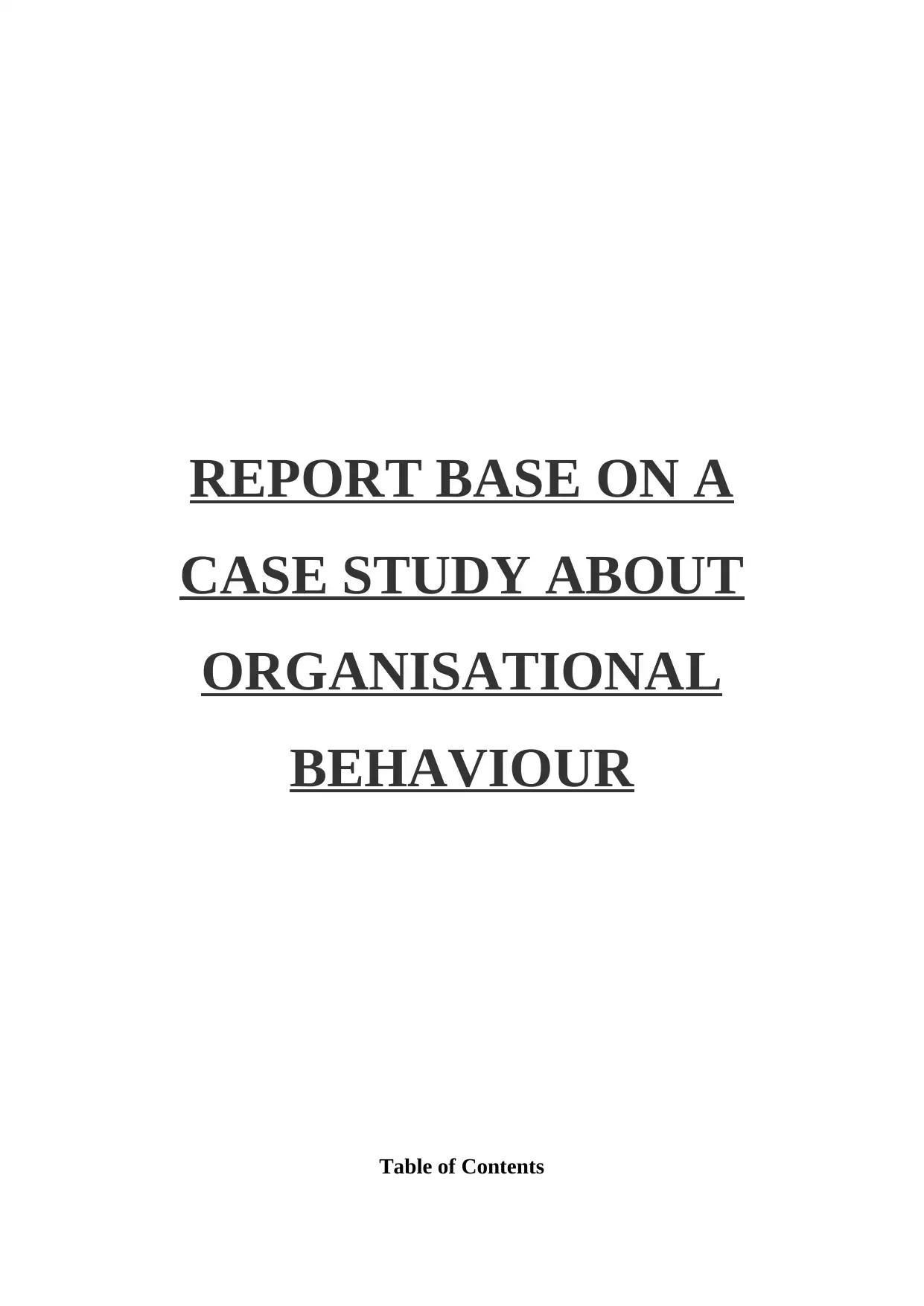
REPORT BASE ON A
CASE STUDY ABOUT
ORGANISATIONAL
BEHAVIOUR
Table of Contents
CASE STUDY ABOUT
ORGANISATIONAL
BEHAVIOUR
Table of Contents
Secure Best Marks with AI Grader
Need help grading? Try our AI Grader for instant feedback on your assignments.
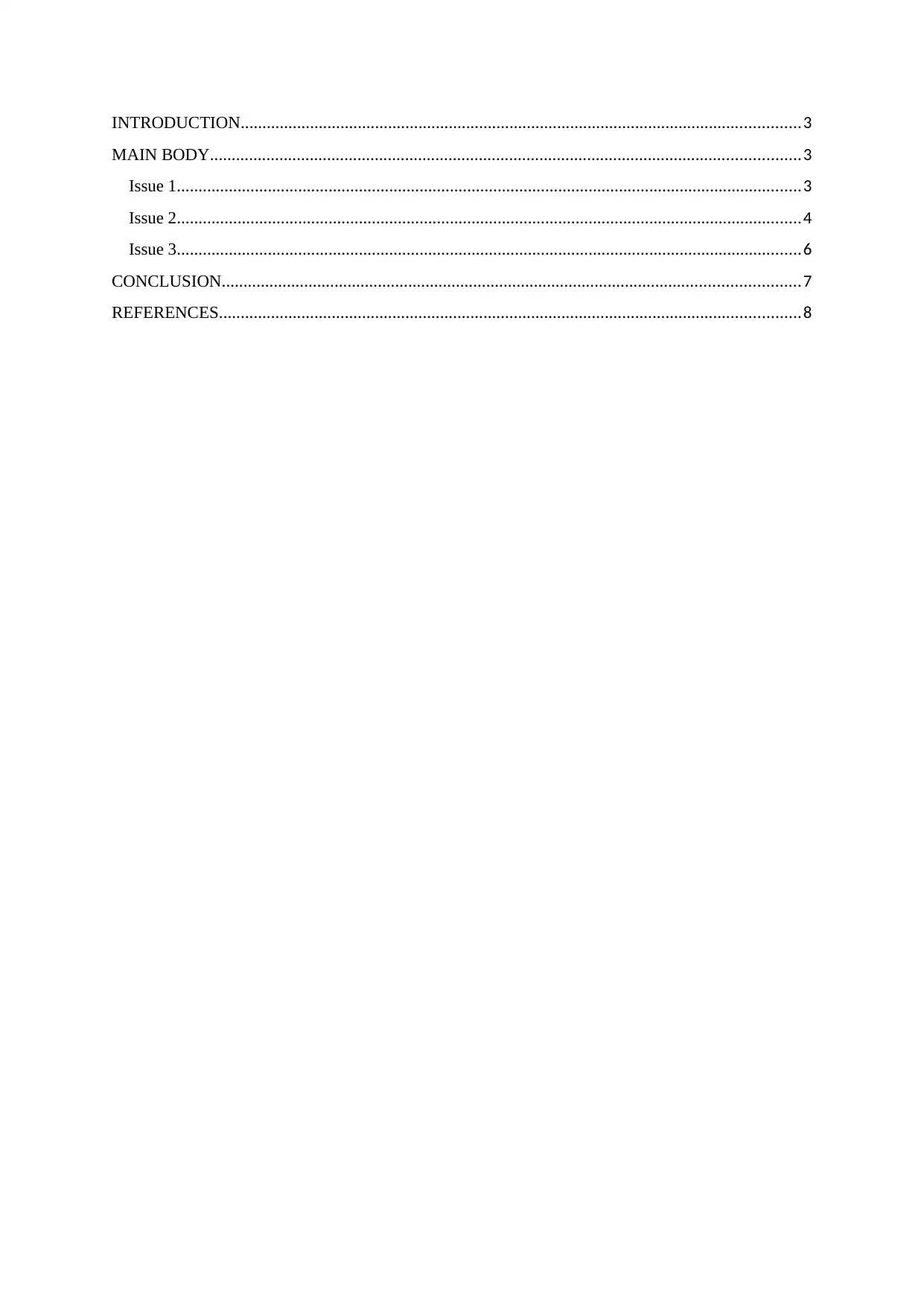
INTRODUCTION.................................................................................................................................3
MAIN BODY........................................................................................................................................3
Issue 1................................................................................................................................................3
Issue 2................................................................................................................................................4
Issue 3................................................................................................................................................6
CONCLUSION.....................................................................................................................................7
REFERENCES......................................................................................................................................8
MAIN BODY........................................................................................................................................3
Issue 1................................................................................................................................................3
Issue 2................................................................................................................................................4
Issue 3................................................................................................................................................6
CONCLUSION.....................................................................................................................................7
REFERENCES......................................................................................................................................8
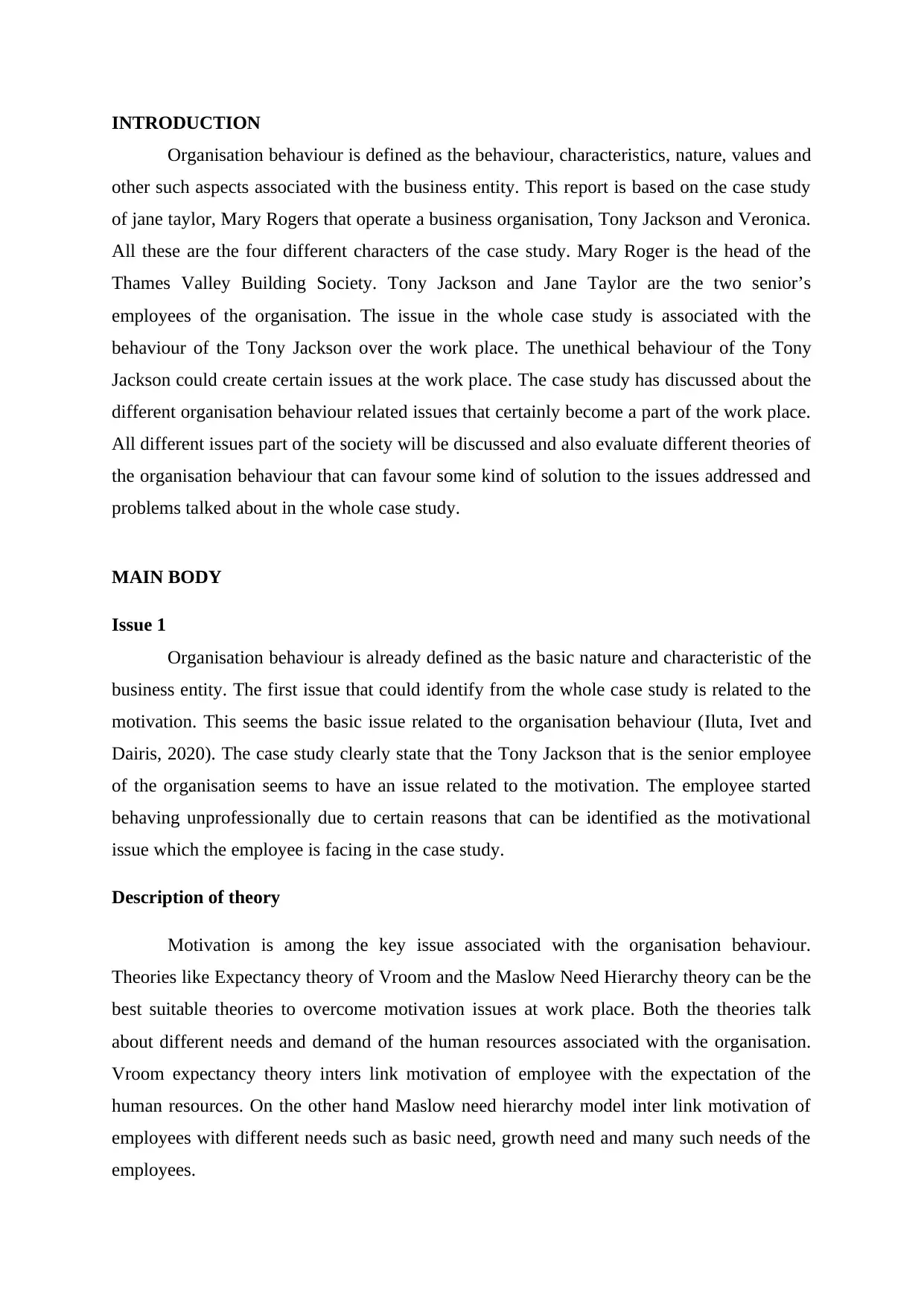
INTRODUCTION
Organisation behaviour is defined as the behaviour, characteristics, nature, values and
other such aspects associated with the business entity. This report is based on the case study
of jane taylor, Mary Rogers that operate a business organisation, Tony Jackson and Veronica.
All these are the four different characters of the case study. Mary Roger is the head of the
Thames Valley Building Society. Tony Jackson and Jane Taylor are the two senior’s
employees of the organisation. The issue in the whole case study is associated with the
behaviour of the Tony Jackson over the work place. The unethical behaviour of the Tony
Jackson could create certain issues at the work place. The case study has discussed about the
different organisation behaviour related issues that certainly become a part of the work place.
All different issues part of the society will be discussed and also evaluate different theories of
the organisation behaviour that can favour some kind of solution to the issues addressed and
problems talked about in the whole case study.
MAIN BODY
Issue 1
Organisation behaviour is already defined as the basic nature and characteristic of the
business entity. The first issue that could identify from the whole case study is related to the
motivation. This seems the basic issue related to the organisation behaviour (Iluta, Ivet and
Dairis, 2020). The case study clearly state that the Tony Jackson that is the senior employee
of the organisation seems to have an issue related to the motivation. The employee started
behaving unprofessionally due to certain reasons that can be identified as the motivational
issue which the employee is facing in the case study.
Description of theory
Motivation is among the key issue associated with the organisation behaviour.
Theories like Expectancy theory of Vroom and the Maslow Need Hierarchy theory can be the
best suitable theories to overcome motivation issues at work place. Both the theories talk
about different needs and demand of the human resources associated with the organisation.
Vroom expectancy theory inters link motivation of employee with the expectation of the
human resources. On the other hand Maslow need hierarchy model inter link motivation of
employees with different needs such as basic need, growth need and many such needs of the
employees.
Organisation behaviour is defined as the behaviour, characteristics, nature, values and
other such aspects associated with the business entity. This report is based on the case study
of jane taylor, Mary Rogers that operate a business organisation, Tony Jackson and Veronica.
All these are the four different characters of the case study. Mary Roger is the head of the
Thames Valley Building Society. Tony Jackson and Jane Taylor are the two senior’s
employees of the organisation. The issue in the whole case study is associated with the
behaviour of the Tony Jackson over the work place. The unethical behaviour of the Tony
Jackson could create certain issues at the work place. The case study has discussed about the
different organisation behaviour related issues that certainly become a part of the work place.
All different issues part of the society will be discussed and also evaluate different theories of
the organisation behaviour that can favour some kind of solution to the issues addressed and
problems talked about in the whole case study.
MAIN BODY
Issue 1
Organisation behaviour is already defined as the basic nature and characteristic of the
business entity. The first issue that could identify from the whole case study is related to the
motivation. This seems the basic issue related to the organisation behaviour (Iluta, Ivet and
Dairis, 2020). The case study clearly state that the Tony Jackson that is the senior employee
of the organisation seems to have an issue related to the motivation. The employee started
behaving unprofessionally due to certain reasons that can be identified as the motivational
issue which the employee is facing in the case study.
Description of theory
Motivation is among the key issue associated with the organisation behaviour.
Theories like Expectancy theory of Vroom and the Maslow Need Hierarchy theory can be the
best suitable theories to overcome motivation issues at work place. Both the theories talk
about different needs and demand of the human resources associated with the organisation.
Vroom expectancy theory inters link motivation of employee with the expectation of the
human resources. On the other hand Maslow need hierarchy model inter link motivation of
employees with different needs such as basic need, growth need and many such needs of the
employees.
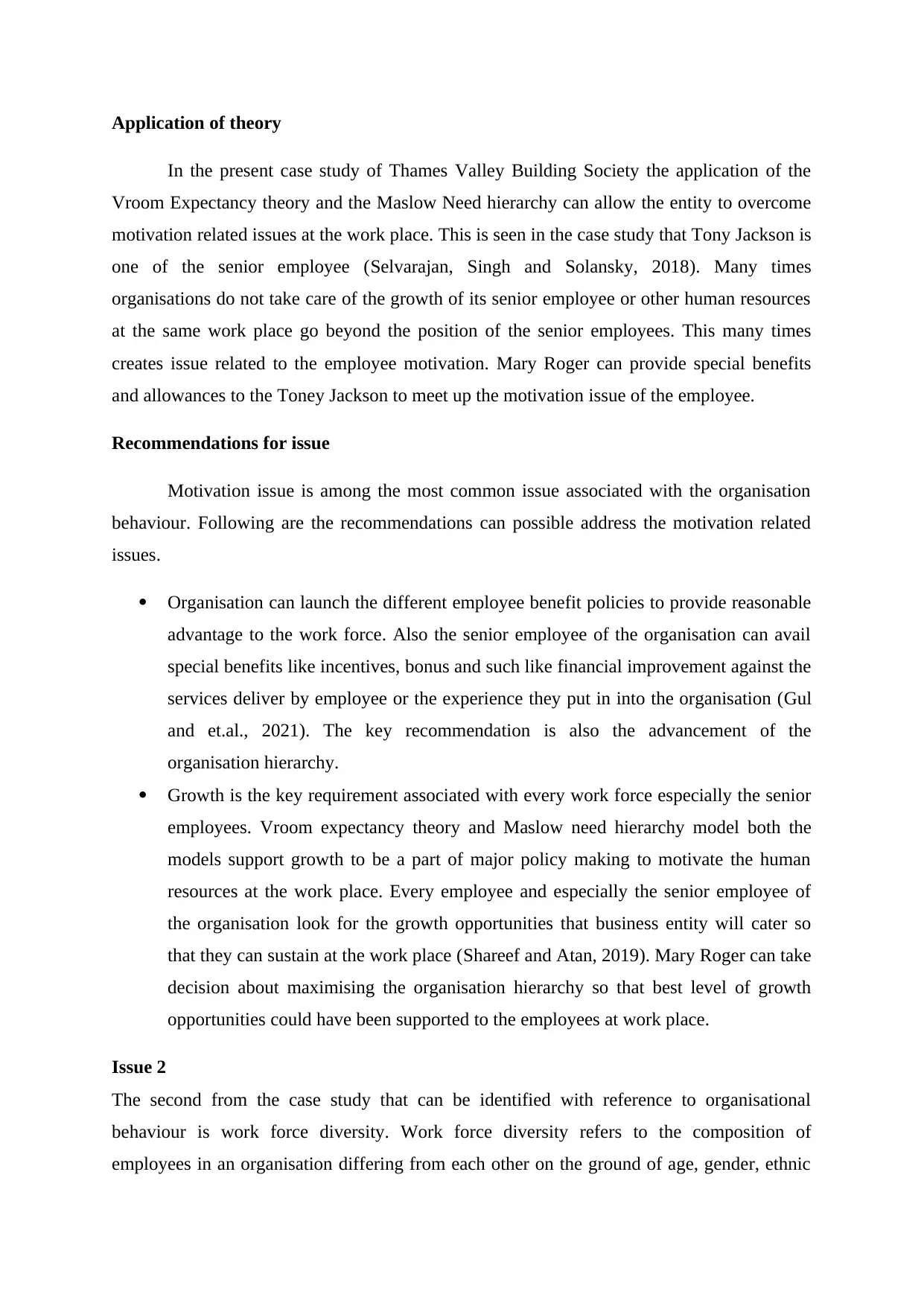
Application of theory
In the present case study of Thames Valley Building Society the application of the
Vroom Expectancy theory and the Maslow Need hierarchy can allow the entity to overcome
motivation related issues at the work place. This is seen in the case study that Tony Jackson is
one of the senior employee (Selvarajan, Singh and Solansky, 2018). Many times
organisations do not take care of the growth of its senior employee or other human resources
at the same work place go beyond the position of the senior employees. This many times
creates issue related to the employee motivation. Mary Roger can provide special benefits
and allowances to the Toney Jackson to meet up the motivation issue of the employee.
Recommendations for issue
Motivation issue is among the most common issue associated with the organisation
behaviour. Following are the recommendations can possible address the motivation related
issues.
Organisation can launch the different employee benefit policies to provide reasonable
advantage to the work force. Also the senior employee of the organisation can avail
special benefits like incentives, bonus and such like financial improvement against the
services deliver by employee or the experience they put in into the organisation (Gul
and et.al., 2021). The key recommendation is also the advancement of the
organisation hierarchy.
Growth is the key requirement associated with every work force especially the senior
employees. Vroom expectancy theory and Maslow need hierarchy model both the
models support growth to be a part of major policy making to motivate the human
resources at the work place. Every employee and especially the senior employee of
the organisation look for the growth opportunities that business entity will cater so
that they can sustain at the work place (Shareef and Atan, 2019). Mary Roger can take
decision about maximising the organisation hierarchy so that best level of growth
opportunities could have been supported to the employees at work place.
Issue 2
The second from the case study that can be identified with reference to organisational
behaviour is work force diversity. Work force diversity refers to the composition of
employees in an organisation differing from each other on the ground of age, gender, ethnic
In the present case study of Thames Valley Building Society the application of the
Vroom Expectancy theory and the Maslow Need hierarchy can allow the entity to overcome
motivation related issues at the work place. This is seen in the case study that Tony Jackson is
one of the senior employee (Selvarajan, Singh and Solansky, 2018). Many times
organisations do not take care of the growth of its senior employee or other human resources
at the same work place go beyond the position of the senior employees. This many times
creates issue related to the employee motivation. Mary Roger can provide special benefits
and allowances to the Toney Jackson to meet up the motivation issue of the employee.
Recommendations for issue
Motivation issue is among the most common issue associated with the organisation
behaviour. Following are the recommendations can possible address the motivation related
issues.
Organisation can launch the different employee benefit policies to provide reasonable
advantage to the work force. Also the senior employee of the organisation can avail
special benefits like incentives, bonus and such like financial improvement against the
services deliver by employee or the experience they put in into the organisation (Gul
and et.al., 2021). The key recommendation is also the advancement of the
organisation hierarchy.
Growth is the key requirement associated with every work force especially the senior
employees. Vroom expectancy theory and Maslow need hierarchy model both the
models support growth to be a part of major policy making to motivate the human
resources at the work place. Every employee and especially the senior employee of
the organisation look for the growth opportunities that business entity will cater so
that they can sustain at the work place (Shareef and Atan, 2019). Mary Roger can take
decision about maximising the organisation hierarchy so that best level of growth
opportunities could have been supported to the employees at work place.
Issue 2
The second from the case study that can be identified with reference to organisational
behaviour is work force diversity. Work force diversity refers to the composition of
employees in an organisation differing from each other on the ground of age, gender, ethnic
Secure Best Marks with AI Grader
Need help grading? Try our AI Grader for instant feedback on your assignments.
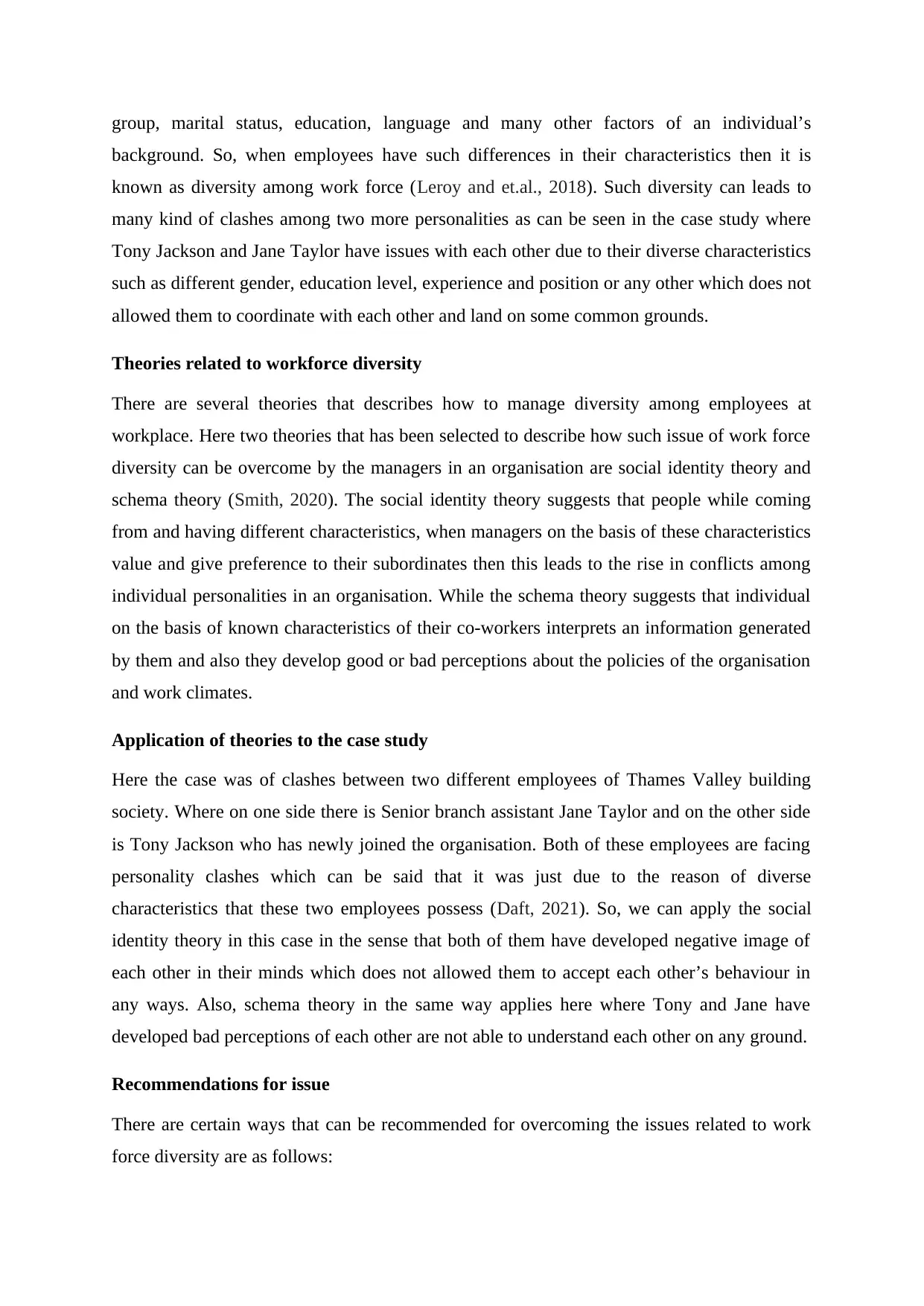
group, marital status, education, language and many other factors of an individual’s
background. So, when employees have such differences in their characteristics then it is
known as diversity among work force (Leroy and et.al., 2018). Such diversity can leads to
many kind of clashes among two more personalities as can be seen in the case study where
Tony Jackson and Jane Taylor have issues with each other due to their diverse characteristics
such as different gender, education level, experience and position or any other which does not
allowed them to coordinate with each other and land on some common grounds.
Theories related to workforce diversity
There are several theories that describes how to manage diversity among employees at
workplace. Here two theories that has been selected to describe how such issue of work force
diversity can be overcome by the managers in an organisation are social identity theory and
schema theory (Smith, 2020). The social identity theory suggests that people while coming
from and having different characteristics, when managers on the basis of these characteristics
value and give preference to their subordinates then this leads to the rise in conflicts among
individual personalities in an organisation. While the schema theory suggests that individual
on the basis of known characteristics of their co-workers interprets an information generated
by them and also they develop good or bad perceptions about the policies of the organisation
and work climates.
Application of theories to the case study
Here the case was of clashes between two different employees of Thames Valley building
society. Where on one side there is Senior branch assistant Jane Taylor and on the other side
is Tony Jackson who has newly joined the organisation. Both of these employees are facing
personality clashes which can be said that it was just due to the reason of diverse
characteristics that these two employees possess (Daft, 2021). So, we can apply the social
identity theory in this case in the sense that both of them have developed negative image of
each other in their minds which does not allowed them to accept each other’s behaviour in
any ways. Also, schema theory in the same way applies here where Tony and Jane have
developed bad perceptions of each other are not able to understand each other on any ground.
Recommendations for issue
There are certain ways that can be recommended for overcoming the issues related to work
force diversity are as follows:
background. So, when employees have such differences in their characteristics then it is
known as diversity among work force (Leroy and et.al., 2018). Such diversity can leads to
many kind of clashes among two more personalities as can be seen in the case study where
Tony Jackson and Jane Taylor have issues with each other due to their diverse characteristics
such as different gender, education level, experience and position or any other which does not
allowed them to coordinate with each other and land on some common grounds.
Theories related to workforce diversity
There are several theories that describes how to manage diversity among employees at
workplace. Here two theories that has been selected to describe how such issue of work force
diversity can be overcome by the managers in an organisation are social identity theory and
schema theory (Smith, 2020). The social identity theory suggests that people while coming
from and having different characteristics, when managers on the basis of these characteristics
value and give preference to their subordinates then this leads to the rise in conflicts among
individual personalities in an organisation. While the schema theory suggests that individual
on the basis of known characteristics of their co-workers interprets an information generated
by them and also they develop good or bad perceptions about the policies of the organisation
and work climates.
Application of theories to the case study
Here the case was of clashes between two different employees of Thames Valley building
society. Where on one side there is Senior branch assistant Jane Taylor and on the other side
is Tony Jackson who has newly joined the organisation. Both of these employees are facing
personality clashes which can be said that it was just due to the reason of diverse
characteristics that these two employees possess (Daft, 2021). So, we can apply the social
identity theory in this case in the sense that both of them have developed negative image of
each other in their minds which does not allowed them to accept each other’s behaviour in
any ways. Also, schema theory in the same way applies here where Tony and Jane have
developed bad perceptions of each other are not able to understand each other on any ground.
Recommendations for issue
There are certain ways that can be recommended for overcoming the issues related to work
force diversity are as follows:
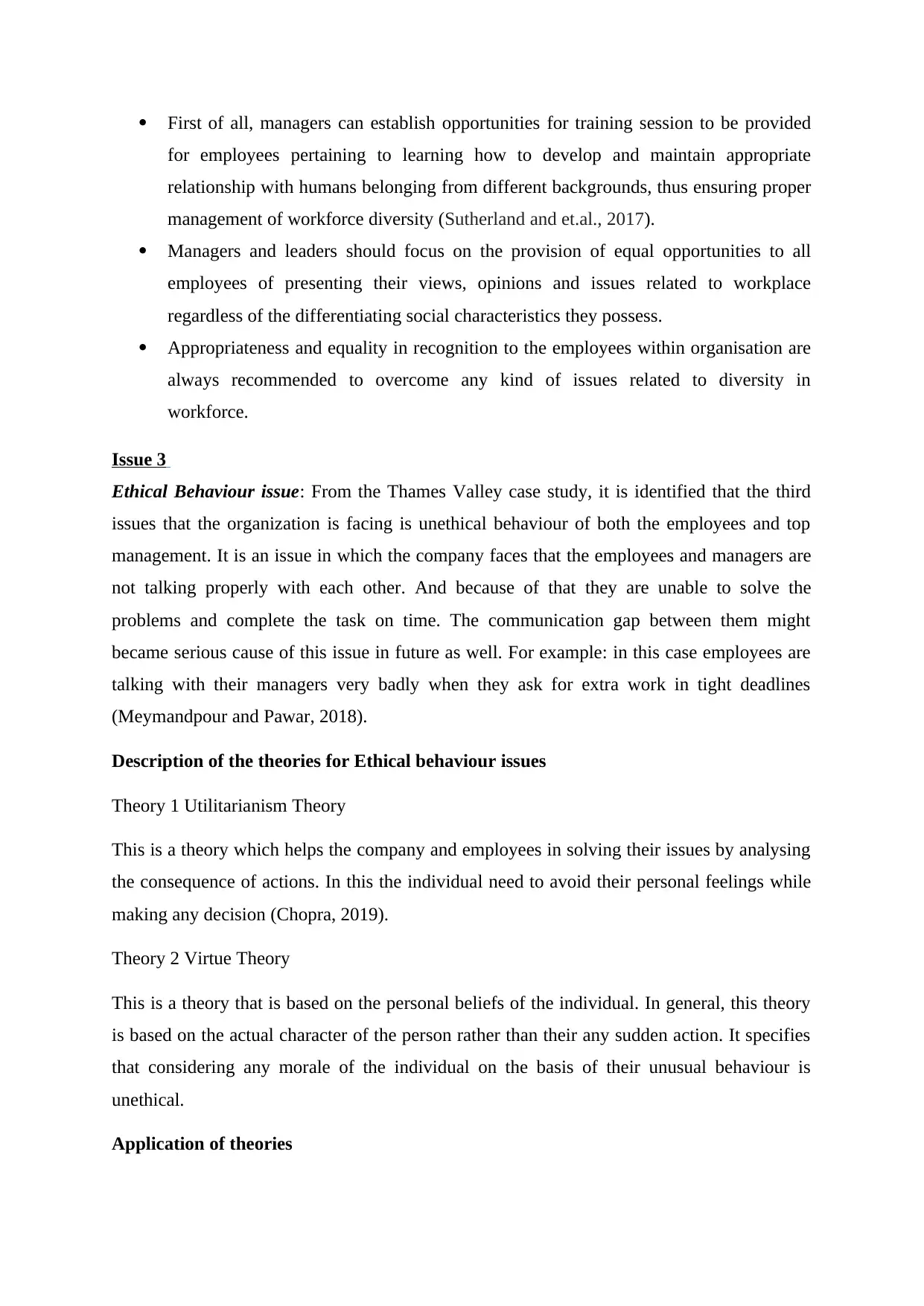
First of all, managers can establish opportunities for training session to be provided
for employees pertaining to learning how to develop and maintain appropriate
relationship with humans belonging from different backgrounds, thus ensuring proper
management of workforce diversity (Sutherland and et.al., 2017).
Managers and leaders should focus on the provision of equal opportunities to all
employees of presenting their views, opinions and issues related to workplace
regardless of the differentiating social characteristics they possess.
Appropriateness and equality in recognition to the employees within organisation are
always recommended to overcome any kind of issues related to diversity in
workforce.
Issue 3
Ethical Behaviour issue: From the Thames Valley case study, it is identified that the third
issues that the organization is facing is unethical behaviour of both the employees and top
management. It is an issue in which the company faces that the employees and managers are
not talking properly with each other. And because of that they are unable to solve the
problems and complete the task on time. The communication gap between them might
became serious cause of this issue in future as well. For example: in this case employees are
talking with their managers very badly when they ask for extra work in tight deadlines
(Meymandpour and Pawar, 2018).
Description of the theories for Ethical behaviour issues
Theory 1 Utilitarianism Theory
This is a theory which helps the company and employees in solving their issues by analysing
the consequence of actions. In this the individual need to avoid their personal feelings while
making any decision (Chopra, 2019).
Theory 2 Virtue Theory
This is a theory that is based on the personal beliefs of the individual. In general, this theory
is based on the actual character of the person rather than their any sudden action. It specifies
that considering any morale of the individual on the basis of their unusual behaviour is
unethical.
Application of theories
for employees pertaining to learning how to develop and maintain appropriate
relationship with humans belonging from different backgrounds, thus ensuring proper
management of workforce diversity (Sutherland and et.al., 2017).
Managers and leaders should focus on the provision of equal opportunities to all
employees of presenting their views, opinions and issues related to workplace
regardless of the differentiating social characteristics they possess.
Appropriateness and equality in recognition to the employees within organisation are
always recommended to overcome any kind of issues related to diversity in
workforce.
Issue 3
Ethical Behaviour issue: From the Thames Valley case study, it is identified that the third
issues that the organization is facing is unethical behaviour of both the employees and top
management. It is an issue in which the company faces that the employees and managers are
not talking properly with each other. And because of that they are unable to solve the
problems and complete the task on time. The communication gap between them might
became serious cause of this issue in future as well. For example: in this case employees are
talking with their managers very badly when they ask for extra work in tight deadlines
(Meymandpour and Pawar, 2018).
Description of the theories for Ethical behaviour issues
Theory 1 Utilitarianism Theory
This is a theory which helps the company and employees in solving their issues by analysing
the consequence of actions. In this the individual need to avoid their personal feelings while
making any decision (Chopra, 2019).
Theory 2 Virtue Theory
This is a theory that is based on the personal beliefs of the individual. In general, this theory
is based on the actual character of the person rather than their any sudden action. It specifies
that considering any morale of the individual on the basis of their unusual behaviour is
unethical.
Application of theories
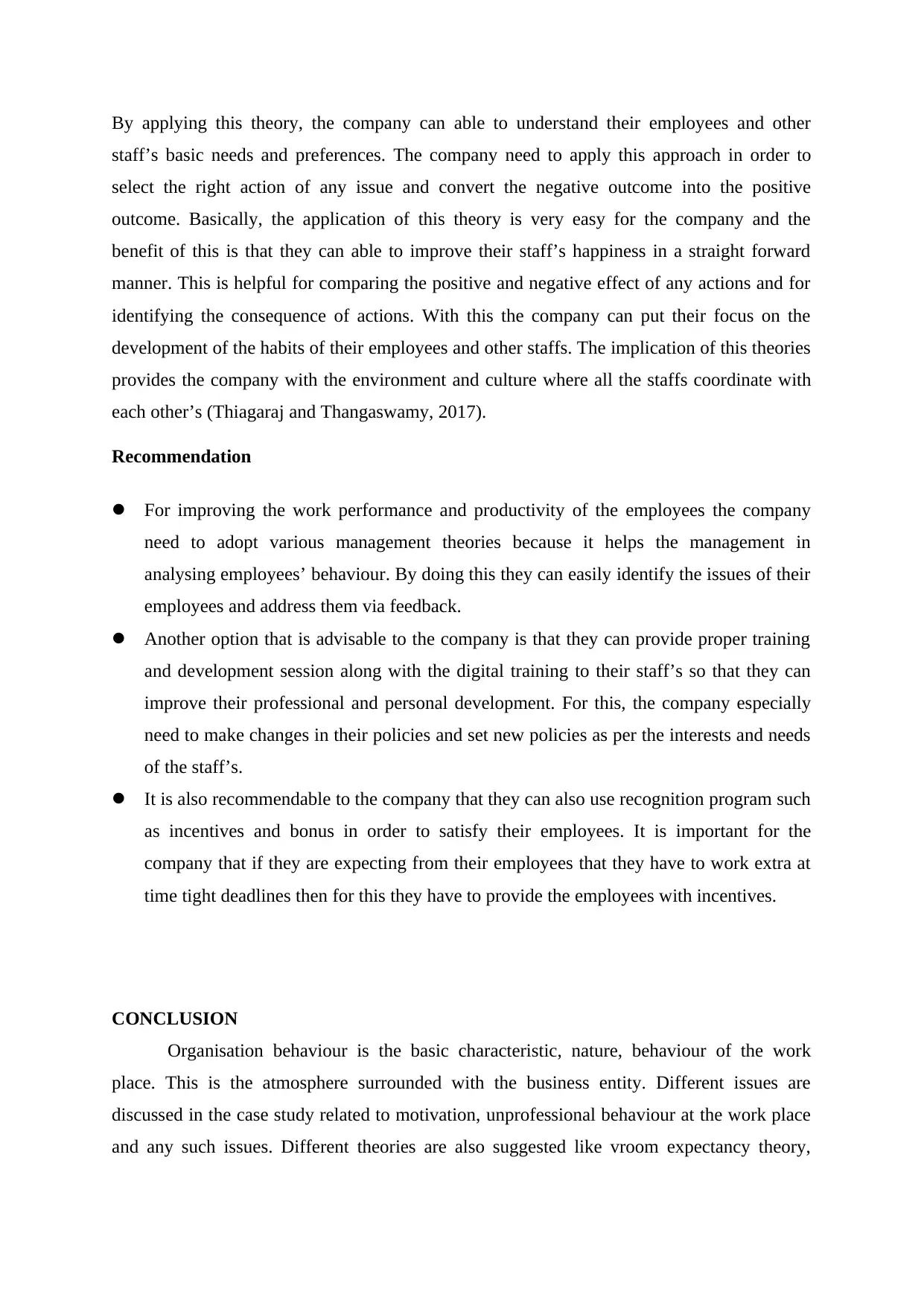
By applying this theory, the company can able to understand their employees and other
staff’s basic needs and preferences. The company need to apply this approach in order to
select the right action of any issue and convert the negative outcome into the positive
outcome. Basically, the application of this theory is very easy for the company and the
benefit of this is that they can able to improve their staff’s happiness in a straight forward
manner. This is helpful for comparing the positive and negative effect of any actions and for
identifying the consequence of actions. With this the company can put their focus on the
development of the habits of their employees and other staffs. The implication of this theories
provides the company with the environment and culture where all the staffs coordinate with
each other’s (Thiagaraj and Thangaswamy, 2017).
Recommendation
For improving the work performance and productivity of the employees the company
need to adopt various management theories because it helps the management in
analysing employees’ behaviour. By doing this they can easily identify the issues of their
employees and address them via feedback.
Another option that is advisable to the company is that they can provide proper training
and development session along with the digital training to their staff’s so that they can
improve their professional and personal development. For this, the company especially
need to make changes in their policies and set new policies as per the interests and needs
of the staff’s.
It is also recommendable to the company that they can also use recognition program such
as incentives and bonus in order to satisfy their employees. It is important for the
company that if they are expecting from their employees that they have to work extra at
time tight deadlines then for this they have to provide the employees with incentives.
CONCLUSION
Organisation behaviour is the basic characteristic, nature, behaviour of the work
place. This is the atmosphere surrounded with the business entity. Different issues are
discussed in the case study related to motivation, unprofessional behaviour at the work place
and any such issues. Different theories are also suggested like vroom expectancy theory,
staff’s basic needs and preferences. The company need to apply this approach in order to
select the right action of any issue and convert the negative outcome into the positive
outcome. Basically, the application of this theory is very easy for the company and the
benefit of this is that they can able to improve their staff’s happiness in a straight forward
manner. This is helpful for comparing the positive and negative effect of any actions and for
identifying the consequence of actions. With this the company can put their focus on the
development of the habits of their employees and other staffs. The implication of this theories
provides the company with the environment and culture where all the staffs coordinate with
each other’s (Thiagaraj and Thangaswamy, 2017).
Recommendation
For improving the work performance and productivity of the employees the company
need to adopt various management theories because it helps the management in
analysing employees’ behaviour. By doing this they can easily identify the issues of their
employees and address them via feedback.
Another option that is advisable to the company is that they can provide proper training
and development session along with the digital training to their staff’s so that they can
improve their professional and personal development. For this, the company especially
need to make changes in their policies and set new policies as per the interests and needs
of the staff’s.
It is also recommendable to the company that they can also use recognition program such
as incentives and bonus in order to satisfy their employees. It is important for the
company that if they are expecting from their employees that they have to work extra at
time tight deadlines then for this they have to provide the employees with incentives.
CONCLUSION
Organisation behaviour is the basic characteristic, nature, behaviour of the work
place. This is the atmosphere surrounded with the business entity. Different issues are
discussed in the case study related to motivation, unprofessional behaviour at the work place
and any such issues. Different theories are also suggested like vroom expectancy theory,
Paraphrase This Document
Need a fresh take? Get an instant paraphrase of this document with our AI Paraphraser
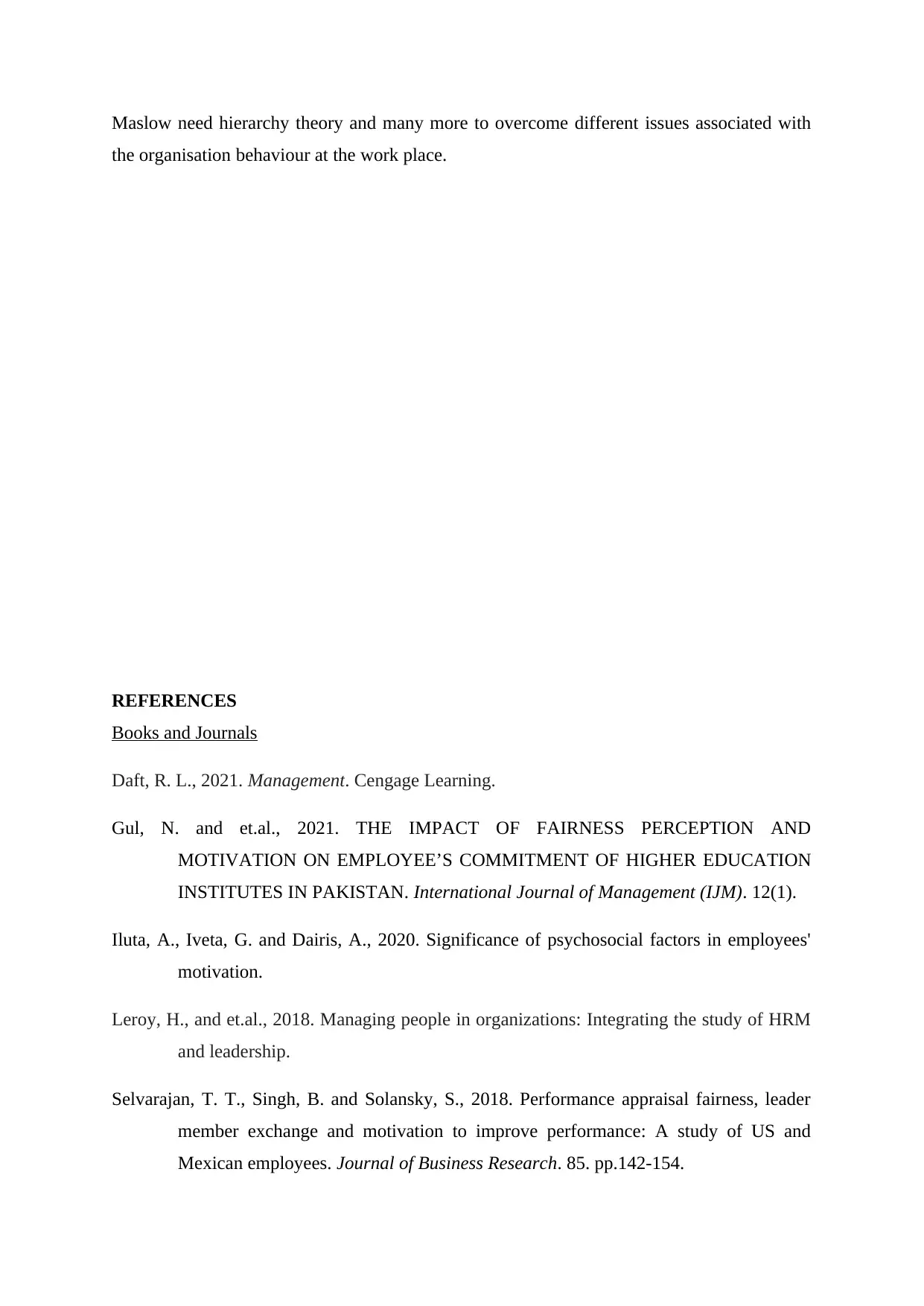
Maslow need hierarchy theory and many more to overcome different issues associated with
the organisation behaviour at the work place.
REFERENCES
Books and Journals
Daft, R. L., 2021. Management. Cengage Learning.
Gul, N. and et.al., 2021. THE IMPACT OF FAIRNESS PERCEPTION AND
MOTIVATION ON EMPLOYEE’S COMMITMENT OF HIGHER EDUCATION
INSTITUTES IN PAKISTAN. International Journal of Management (IJM). 12(1).
Iluta, A., Iveta, G. and Dairis, A., 2020. Significance of psychosocial factors in employees'
motivation.
Leroy, H., and et.al., 2018. Managing people in organizations: Integrating the study of HRM
and leadership.
Selvarajan, T. T., Singh, B. and Solansky, S., 2018. Performance appraisal fairness, leader
member exchange and motivation to improve performance: A study of US and
Mexican employees. Journal of Business Research. 85. pp.142-154.
the organisation behaviour at the work place.
REFERENCES
Books and Journals
Daft, R. L., 2021. Management. Cengage Learning.
Gul, N. and et.al., 2021. THE IMPACT OF FAIRNESS PERCEPTION AND
MOTIVATION ON EMPLOYEE’S COMMITMENT OF HIGHER EDUCATION
INSTITUTES IN PAKISTAN. International Journal of Management (IJM). 12(1).
Iluta, A., Iveta, G. and Dairis, A., 2020. Significance of psychosocial factors in employees'
motivation.
Leroy, H., and et.al., 2018. Managing people in organizations: Integrating the study of HRM
and leadership.
Selvarajan, T. T., Singh, B. and Solansky, S., 2018. Performance appraisal fairness, leader
member exchange and motivation to improve performance: A study of US and
Mexican employees. Journal of Business Research. 85. pp.142-154.
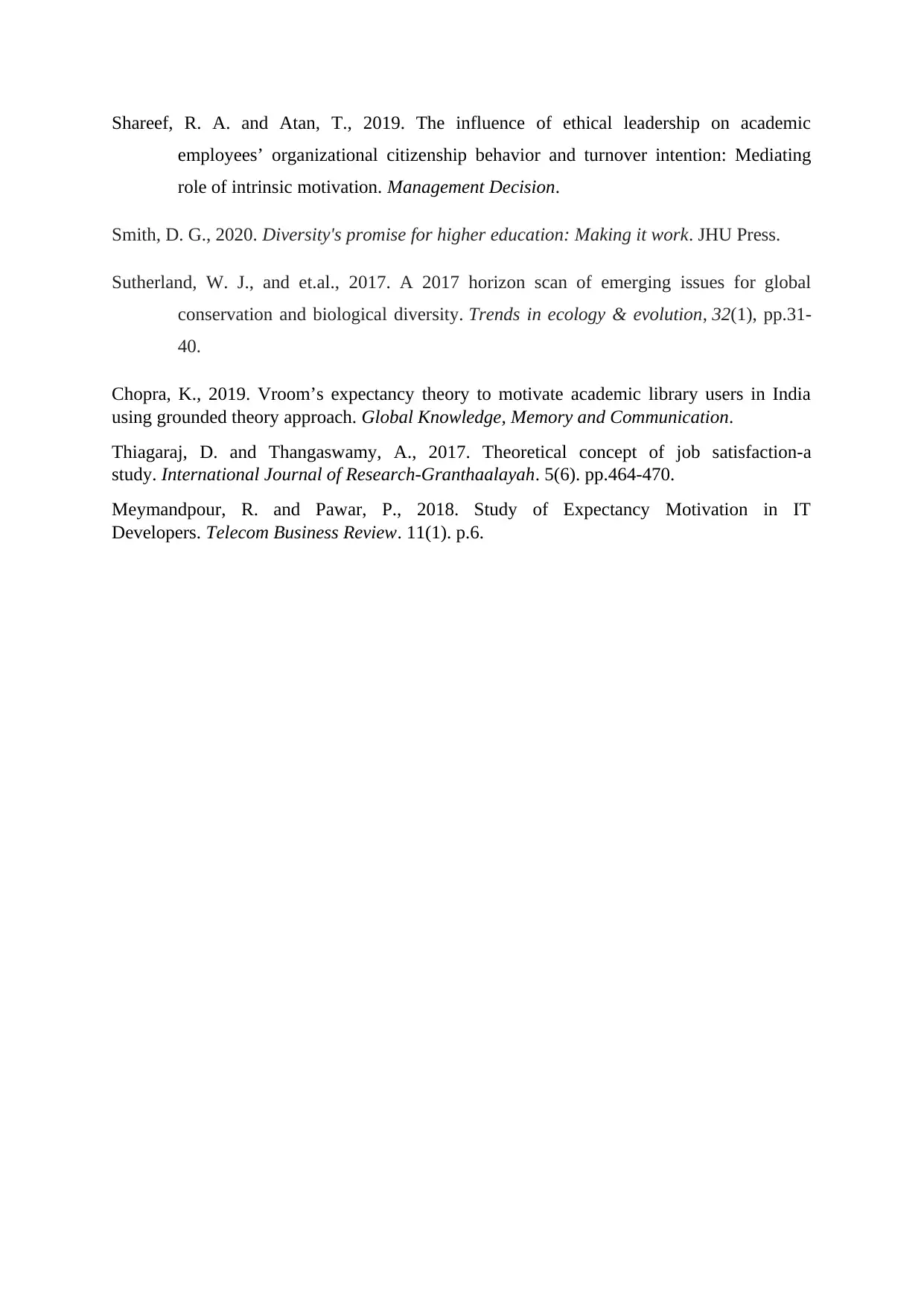
Shareef, R. A. and Atan, T., 2019. The influence of ethical leadership on academic
employees’ organizational citizenship behavior and turnover intention: Mediating
role of intrinsic motivation. Management Decision.
Smith, D. G., 2020. Diversity's promise for higher education: Making it work. JHU Press.
Sutherland, W. J., and et.al., 2017. A 2017 horizon scan of emerging issues for global
conservation and biological diversity. Trends in ecology & evolution, 32(1), pp.31-
40.
Chopra, K., 2019. Vroom’s expectancy theory to motivate academic library users in India
using grounded theory approach. Global Knowledge, Memory and Communication.
Thiagaraj, D. and Thangaswamy, A., 2017. Theoretical concept of job satisfaction-a
study. International Journal of Research-Granthaalayah. 5(6). pp.464-470.
Meymandpour, R. and Pawar, P., 2018. Study of Expectancy Motivation in IT
Developers. Telecom Business Review. 11(1). p.6.
employees’ organizational citizenship behavior and turnover intention: Mediating
role of intrinsic motivation. Management Decision.
Smith, D. G., 2020. Diversity's promise for higher education: Making it work. JHU Press.
Sutherland, W. J., and et.al., 2017. A 2017 horizon scan of emerging issues for global
conservation and biological diversity. Trends in ecology & evolution, 32(1), pp.31-
40.
Chopra, K., 2019. Vroom’s expectancy theory to motivate academic library users in India
using grounded theory approach. Global Knowledge, Memory and Communication.
Thiagaraj, D. and Thangaswamy, A., 2017. Theoretical concept of job satisfaction-a
study. International Journal of Research-Granthaalayah. 5(6). pp.464-470.
Meymandpour, R. and Pawar, P., 2018. Study of Expectancy Motivation in IT
Developers. Telecom Business Review. 11(1). p.6.
1 out of 9
Related Documents
Your All-in-One AI-Powered Toolkit for Academic Success.
+13062052269
info@desklib.com
Available 24*7 on WhatsApp / Email
![[object Object]](/_next/static/media/star-bottom.7253800d.svg)
Unlock your academic potential
© 2024 | Zucol Services PVT LTD | All rights reserved.





